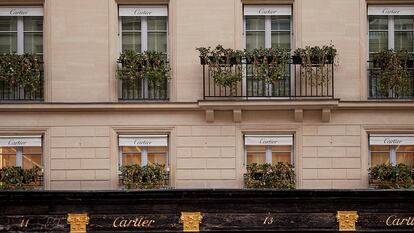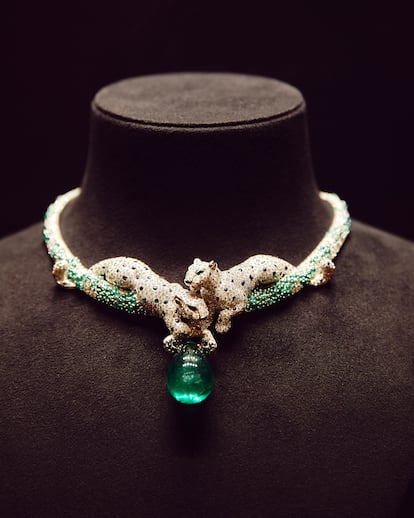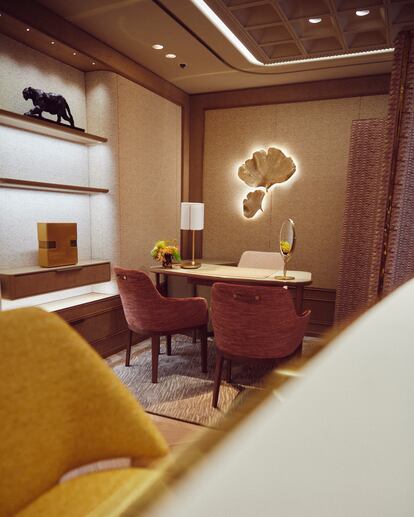Paris is still the luxury capital of the world
Cartier’s historic flagship store has reopened after two and a half years of renovations

Thousands of demonstrators have been flooding the streets of Paris to protest the rising cost of living, but for some, the party goes on. There are private showings, soirées, dinners, parties and after-parties – 15 of them on one night in Paris. In front of 13 Rue de la Paix, Lou Doillon, Jane Birkin’s dilettante daughter, and Farida Khelfa, ex-model and muse turned documentary filmmaker, are waiting behind a velvet rope and having a smoke. It’s a different kind of demonstration, one that was organized by Cartier last fall to celebrate the reopening of its historic flagship store in the French capital after extensive renovations. It’s now all bright and shiny, and ready to serve a certain class of consumers. What inflation?
“Things are strange right now,” said Cartier’s Pierre Rainero. “People are talking about economic crisis and instability, but the city is full of tourists, especially Europeans. People seem to have a huge appetite for Paris, which may be one of the consequences of the pandemic. That means we have to move forward because our customers are moving forward.” Rainero has been the guardian of Cartier’s heritage for almost 40 years. The “king of jewelers and jeweler of kings,” Cartier has reopened the doors of its flagship Paris boutique following an extensive renovation, a project that Rainero says was undertaken out of pragmatism, not romanticism. “Let’s just say there was a gap between the prestige of this location and its capacity to properly welcome clients,” he said. Rue de la Paix is not Cartier’s largest store (the one on the Champs Elysées is bigger), but it’s the oldest. And it’s where it all began.

The streets of Paris were also bustling as the 19th century waned, but not from any sense of social discontent. An estimated 200,000 daily pedestrians walked the brand-new, elegant boulevards designed by Georges-Eugène Haussmann at the behest of Emperor Napoleon III. French author Émile Zola called it the “new Paris,” and Rue de la Paix cut through the city from the Garnier opera house through the Tuileries Garden all the way to the Rue de Castiglione and the Place Vendôme. It was the place to be, of course, full of banks, cafés, fancy hotels, jewelers, watchmakers, perfumers and fashion houses. The fact that the renowned Worth fashion house set up shop at 7 Rue de la Paix was decisive for Alfred Cartier, son of founder Louis-François, when he moved the original store to its new location on the fashionable street. Alfred’s son Louis, who would later turn Cartier into a household name, was married to a granddaughter of Charles Frederick Worth, the designer who dominated Parisian fashion in the latter half of the 19th century. The new Cartier store opened in 1899, and 123 years later, the only original element remaining is the Portoro black marble with gold veins on the lower façade. It’s a comforting reminder that Paris is still Paris.

Two and a half years of extensive renovation work transformed the 7,500 square-foot (700 square meters) interior into over 32,000 square feet (3,000 square meters), with six stories overlooking a large atrium. Natural lighting is finally illuminating 13 Rue de la Paix. “It was the logical thing to do so we could have a more space to accommodate different customer experiences and various displays of our collections. Ambience can change how people perceive the pieces, so it’s up to us to demonstrate all the possibilities,” said Rainero. Everything in the renovated establishment revolves around the buyers, who are offered a complete experience, whether they are buying or just browsing. “We want to challenge their tastes and start a conversation so they can get other opinions,” said Rainero. “The internet has changed the way we shop, and we have to respond to that.” Regarding younger shoppers, Rainero said, “They have torn down the walls of luxury, and are no longer afraid of it.”

Three architectural firms were engaged for the renovation project: Moinard Bétaille, Studioparisien and Laura Gonzalez. All three have long-standing relationships with Cartier and have left their imprint on other stores and projects. But the Rue de la Paix project transcended everything they had done before. The architects reimagined rooms like the offices of Louis Cartier and Jeanne Toussaint (the first artistic director and creator of the iconic Panthère line), and created sumptuous private-viewing lounges with art deco, Indian and Islamic themes. They built a huge archive and workshops where most of the pieces are designed and created. The icing on the cake is the Gonzalez-designed La Résidence penthouse, a cozy living and dining room for exclusive celebrations and entertaining VIP visitors. “Transforming the store into spaces with the warmth of a home strengthens customer connections. It’s an evolution of the sales floor, which is no longer limited to product display, but also provides an immersion into the brand’s world,” said the French interior designer with Spanish roots.

Master artisans were commissioned for many elements of the renovation, such as stonemason Hervé Obligi, cabinetmaker Lison de Caunes, mosaic art studio Lilipkó, and lacquerer Anne Midavaine. Cartier firmly believes in the preservation and continuity of ancestral, handmade crafts. “Style aside, our values must be expressed in the architecture and décor. After all, you are in Cartier, not in just any store,” said Rainero. “And this one is special – the oldest – with all its legacy. It’s where the historic collections began, and it’s the store that catered to British and Spanish royalty. But we should not forget that it’s also where the modern Cartier started, where its great designers worked, and key decisions were made. Our mission has always been to create collections that are relevant to their times. It’s the same with all our boutiques, but we don’t compromise the vision. We don’t change just for the sake of change.”
Sign up for our weekly newsletter to get more English-language news coverage from EL PAÍS USA Edition
Tu suscripción se está usando en otro dispositivo
¿Quieres añadir otro usuario a tu suscripción?
Si continúas leyendo en este dispositivo, no se podrá leer en el otro.
FlechaTu suscripción se está usando en otro dispositivo y solo puedes acceder a EL PAÍS desde un dispositivo a la vez.
Si quieres compartir tu cuenta, cambia tu suscripción a la modalidad Premium, así podrás añadir otro usuario. Cada uno accederá con su propia cuenta de email, lo que os permitirá personalizar vuestra experiencia en EL PAÍS.
¿Tienes una suscripción de empresa? Accede aquí para contratar más cuentas.
En el caso de no saber quién está usando tu cuenta, te recomendamos cambiar tu contraseña aquí.
Si decides continuar compartiendo tu cuenta, este mensaje se mostrará en tu dispositivo y en el de la otra persona que está usando tu cuenta de forma indefinida, afectando a tu experiencia de lectura. Puedes consultar aquí los términos y condiciones de la suscripción digital.
More information
Archived In
Últimas noticias
Welcome to the post-religion era: The idea of Christianity as the absolute truth has become obsolete
‘I thought you would like it’: The risky sexual practice popularized by TV shows and TikTok
The digitalization of tourism: ‘They promise experiences and gave us the worst possible one’
Mexican peso defies uncertainty with forecasts of a new period of stability in 2026
Most viewed
- Sinaloa Cartel war is taking its toll on Los Chapitos
- Oona Chaplin: ‘I told James Cameron that I was living in a treehouse and starting a permaculture project with a friend’
- Reinhard Genzel, Nobel laureate in physics: ‘One-minute videos will never give you the truth’
- Why the price of coffee has skyrocketed: from Brazilian plantations to specialty coffee houses
- Silver prices are going crazy: This is what’s fueling the rally










































